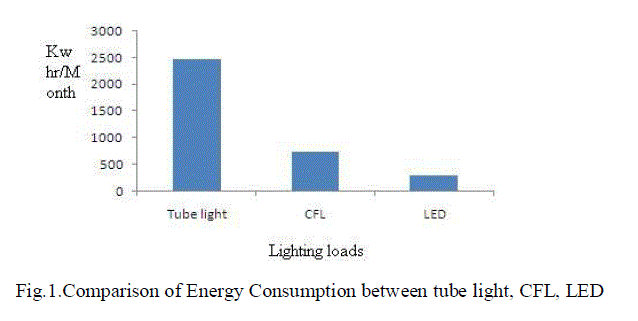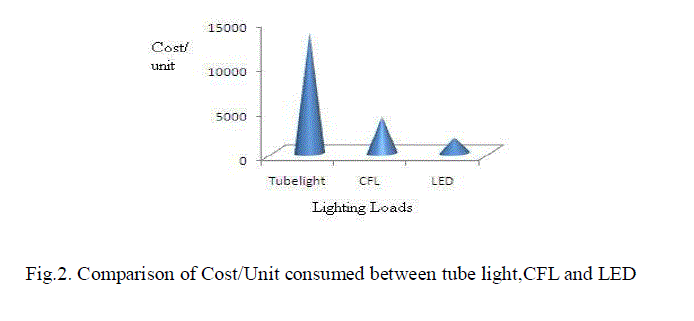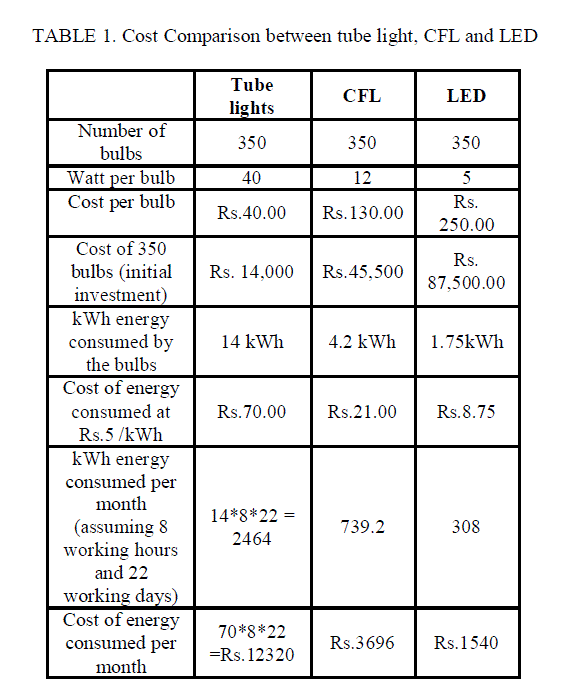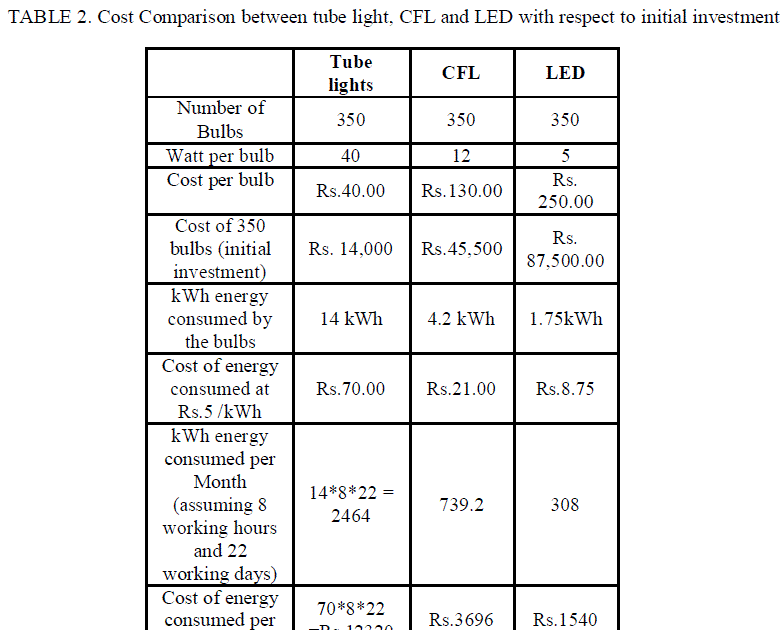ISSN ONLINE(2278-8875) PRINT (2320-3765)
ISSN ONLINE(2278-8875) PRINT (2320-3765)
|
Ramya.L.N and M.A.Femina
|
| Related article at Pubmed, Scholar Google |
Visit for more related articles at International Journal of Advanced Research in Electrical, Electronics and Instrumentation Engineering
Energy demand is an increasing pressure for any government. For the developing country like India, the energy generated decides the economic growth of the country. Being the fifth largest power generator and the fourth largest power consumer in the world, energy demand and scarcity rules the country. Energy demand in our country is increasing exponentially. Energy conservation can be the best solution for the raising energy demand. Energy audit is the best solution for the energy conservation where the system is well analyzed and a report stating the possible changes in the system with no negative output is evaluated. The paper focuses on the importance of energy auditing by considering the conventional lighting loads of an educational institution and replacing with energy efficient lamps and comparing the results.
Keywords |
| Energy Demand, Energy Auditing, Lighting Loads, Energy Conservation |
INTRODUCTION |
| Availability of power is the major deciding factor of a developing country. Power demands are increasing day by day and conservation of energy is an important need of a country. In India, one of the fastest developing country in the world, the total installed power capacity is around 233.92 GW, world’s fifth largest, out of which 159.7 GW are generated from thermal power stations, 4.78 GW from nuclear power stations, 39.893 GW from hydro power plants and 29.462 GW are from renewable energy sources. |
| In spite of this, India currently suffers from a major shortage of electricity generation capacity, even though it is the world's fourth largest energy consumer. Of the 1.4 billion people of the world who have no access to electricity in the world, India accounts for over 300 million. As of January 2012, the per capita total consumption in India to be 778 kWh. |
| In a May 2011 report, India's Central Electricity Authority anticipated, for 2011–12-year, a base load energy deficit and peaking shortage to be 10.3% and 12.9% respectively. The 17th electric power survey of India report claims over 2010– 11, India's industrial demand accounted for 35% of electrical power requirement, domestic household use accounted for 28%, agriculture 21%, commercial 9% public lighting and other miscellaneous applications accounted for the rest.[2] |
| Energy conservation can be a good solution to all the energy demands. Energy conservation means reducing energy consumption using less of an energy service. Energy audit is an efficient service which investigates the possible ways of energy conservation in a building or a system without negative output. |
ENERGY AUDITING |
| As per the Energy Conservation Act, 2001, Energy Audit is defined as "the verification, monitoring and analysis of use of energy including submission of technical report containing recommendations for improving energy efficiency with cost benefit analysis and an action plan to reduce energy consumption". Implementation of recommended measures can help consumes to achieve significant reduction in their energy consumption levels. [3] |
| An energy audit is an inspection, survey and analysis of energy flow for energy conservation in a building or system to reduce the amount of energy input into the system without negatively affecting the outputs. The objective of this paper is to study the energy consumption of an educational building and reduce the consumption without affecting the output. The institutional building is considered here because of the uncontrolled and unpredictable usage of light, fans and air conditioning facilities in number of classrooms, practical rooms, auditoriums and also rooms with computer facilities and UPS. |
| Energy audit analysis in general order involves: |
| • Analysis of the energy consumable systems and the utility bills |
| • Survey about the condition of the system |
| • Understanding the need of the consumer |
| • Evaluating the possible energy conservation measures and |
| • Estimating the energy savings potential. |
| Studies and researchers have shown that energy auditing and conservation in India can save approximately Rs.1800 crores per year as there is a big potential for saving energy in industrial sector and save installation equivalent to 5250 MW. |
TYPES OF ENERGY AUDITING |
| Energy audit is very essential in all the sectors and the type of energy audit to be performed depends mainly on the consumer’s need. There are mainly four types of energy auditing [4]: |
| • Bench marking |
| • Walk-through or preliminary audit |
| • General audit |
| • Investment-grade audit |
| Bench Marking: Benchmarking mainly consists in comparing the measured consumption with reference consumption of other similar buildings or generated by simulation tools to identify excessive or unacceptable running costs. As mentioned before, benchmarking is also necessary to identify buildings presenting interesting energy saving potential. An important issue in benchmarking is the use of performance indexes to characterize the building. |
| Walk-through audit: The simplest and quickest type of audit is preliminary audit. It is also called a simple audit, screening audit or walk-through audit. It involves minimal interviews with site-operating personnel, a brief review of facility utility bills and other operating data, and a walk-through of the facility to become familiar with the building operation. Only major problem areas will be covered during this type of audit. |
| General Audit: The general audit also called mini-audit, site energy audit or detailed energy audit or complete site energy audit expands on the preliminary audit .Utility bills are collected for a 12 to 36 month period to allow the auditor to evaluate the facility's energy demand rate structures and energy usage profiles. This type of audit will be able to identify all energy-conservation measures appropriate for the facility, given its operating parameters. |
| Investment grade Audit: In most corporate settings, upgrades to a facility's energy infrastructure must compete for capital funding with non-energy-related investments. Both energy and non-energy investments are rated on a single set of financial criteria that generally stress the expected return on investment (ROI). The projected operating savings from the implementation of energy projects must be developed such that they provide a high level of confidence. In fact, investors often demand guaranteed savings. |
MEASURES IN ENERGY AUDITING OF EDUCATIONAL BUILDING |
| An educational building is selected for the energy auditing due to the fact that the number of people involved in an educational building is huge and the possibility of energy conservation is more. |
| Lighting load is where most of the energy is wasted than consumed. In any educational building, lighting load consumes more than 20% of the total electrical energy consumption. Replacing the regular tube lights employing electromagnetic ballast with Compact Florescent Lights (CFLs) and Light Emitting Diodes (LEDs) is discussed in the paper. The total tube light load of the building is around 61.63kW employing 350 lamps. |
REVIEW OF LIGHTING LOADS |
| Several places are identified during the audit, as the place for easy and efficient energy savings. A count on lighting is done after proper identification and calculation about the replacement of the light as it should not affect the consumers need. In the analysis, the energy consumption of tube lights, CFLs and LEDs are evaluated and compared. |
| Florescent tubes: The usage of 40 W tube light consumes the specified energy: Total number of tube lights being 350, total energy consumed by the tube lights is 350*40*1 = 14kWhour. Assuming 8 working hours a day and 22 working days per month, total energy consumption by the tube lights are 14000*8*22=2464kWh. The cost wise comparison is also done assuming Rs.5.00 per unit. The total amount is 2462*5.00 = Rs. 12310.00 per month. |
| CFLs: Replacing the 40W tube lights with 12 watts CFLs [5], total energy consumed by 350 CFLs is, 350*12*1 = 4.2kWhour. Assuming 8 working hours a day and 22 working days per month, total energy consumed by the CFLs are 4200*8*22=739.2kWh. The cost wise comparison is also done assuming Rs.5.00 per unit. The total amount is 739.2*5.00 = Rs. 3696.00 per month. |
| LEDs: Replacing the 40W tube lights with 5 watts LEDs [6], total energy consumed by 350 LEDs are, 350 *5*1= 1.75kW hour. Assuming 8 working hours a day and 22 working days per month, total energy consumed by the LEDs is 1750*8*22=308 KW. The cost wise comparison is also done assuming Rs.5.00 per unit. The total amount is 308*5.00 = Rs. 1540.00 |
| Fig 1. shows the energy consumption comparison between tube light, CFL and LED. |
 |
| Fig.2. shows the comparison of cost/unit consumed between tube light, CFL and LED. |
 |
| Comparison between tube light, CFL and LED : The table below shows the cost wise comparison between the tube light, CFL and LED [6]. The values discussed in the table are approximate values only. |
 |
| The above table compares the tube light and CFL with respect to the life span of LED. As seen, the life span of a LED is approximately 50,000 hours which is approximately 40 times more than the life span of tube light and 5 times more than the life span of CFL. |
| The pay back from the CFL and LED is more than the tube light as the energy consumed by the CFL and LED is less when compared with tube light. From the table it can be seen that, for 50,000 hours, i.e., in the life span of one LED, 5 CFLs and 42 tube lights are used. |
| The table 2 discusses the break even after replacing the 350 tube lights by CFLs and 350 LEDs in the educational institution considered in the paper. The values discussed in the table are approximate values only. |
| From the table it is clear that, energy consumed by tube light for 1 hour is equal to the energy consumed by the CFL for 3 hours and that of LED for 8 hours. |
| Cost difference between the energy consumed by the tube light and that of CFL per month assuming 8 working hours and 22 working days is Rs.8624.00. The initial investment in replacing the existing tube lights with CFL is Rs.45, 500.00. This implies that the break even occurs at 5.2 months. So CFL bulb starts to pay back after 5.2 months. |
| Cost difference between the energy consumed by the tube light and that of LED per month assuming 8 working hours and 22 working days is Rs.10,780.00. The initial investment in replacing the existing tube lights with LED is Rs.87, 500.00. This implies that the break even occurs at 8.1 months. So LED bulb starts to pay back after 8.1 months. |
 |
CONCLUSION |
| The above discussions show that replacing the conventional tube lights with energy saving CFLs or LEDs reduces the energy consumption drastically. In addition to this the CO2 emission is also reduced when the tube lights are replaced. Replacing a single tube light with a CFL will keep a half-ton of CO2 out of the atmosphere over the life of the bulb [7]. A simple change in system can conserve energy and bring down the utility bill amount to a greater extent. |
| Energy audit in all the sectors with few changes in the existing system can conserve energy, which in turn will reduce the power demands in our country. The government can decide policies to initiate the energy audit in all the sectors which will make a great change in the economical status of India in the global market. |
RECOMMENDATIONS |
| Well lit airy classrooms with insulated ceiling can reduce the energy consumption. Switching off the unused electrical appliances is the best energy conservation one can do. Setting timers for air conditioning units, installing automated sensor based fans and lights, replacing the copper ballast of the tube lights with electronic ballasts can reduce the energy consumption. |
| Using the computer, one of the widely used machine, at the optimum brightness level, which is 15 to 30 percentage in each LCD monitors, can reduce power drawn by three to five watts per computer. For every kilowatt hour of energy saved, 0.9 kg of carbon dioxide emission is reduced. Saving energy will help reduce carbon footprints on earth and help save the green cover of our planet. Incorporating reactive power compensations also reduces the utility bill amount. |
References |
|